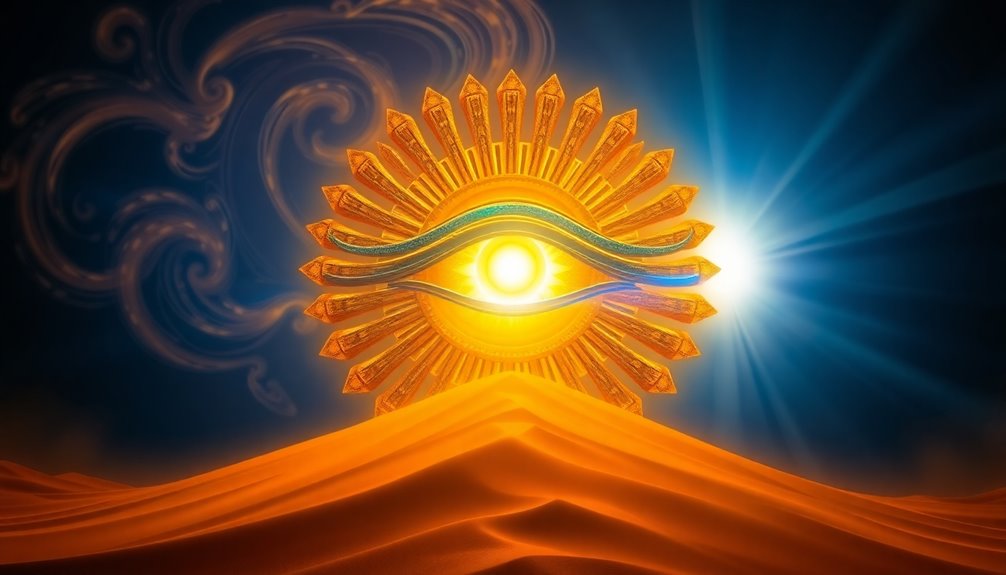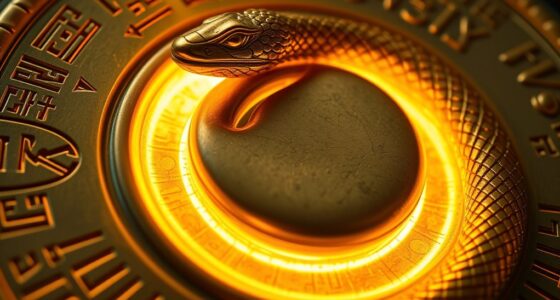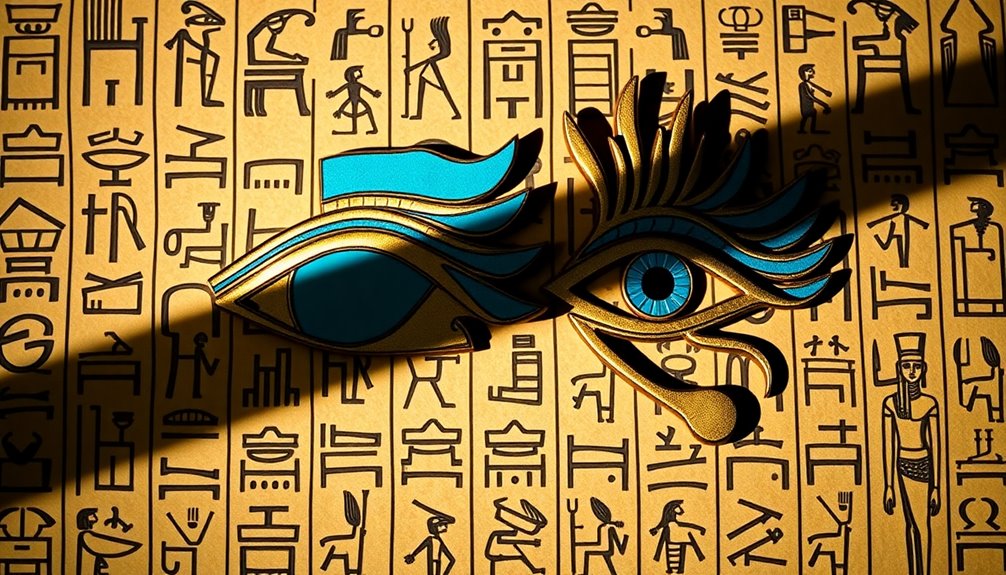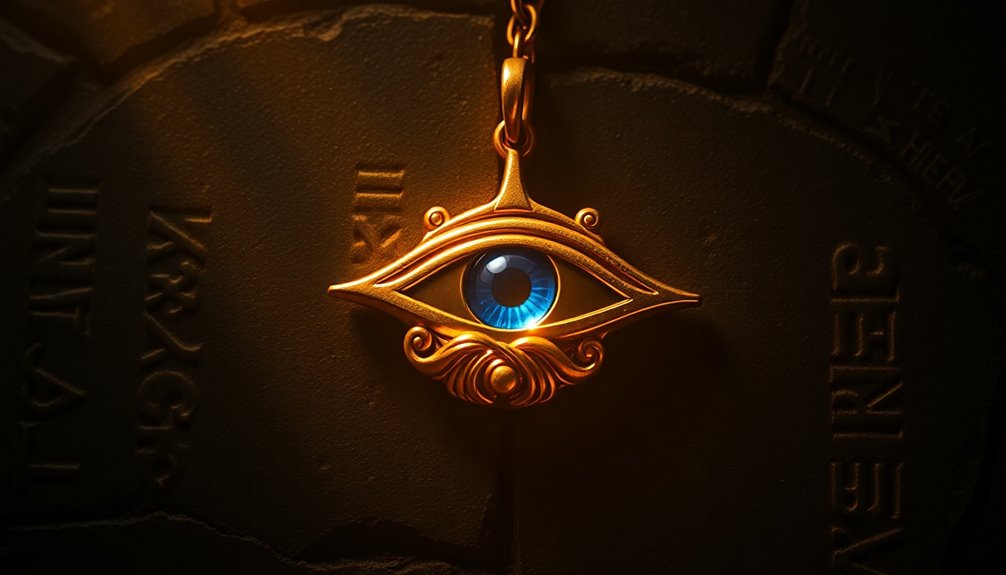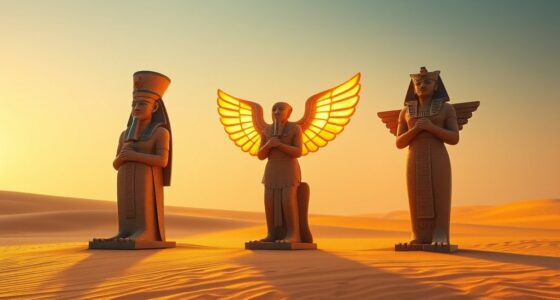In the ancient Egyptian mythology showdown between the Eye of Horus and the Eye of Ra, you're witnessing a clash of symbolism. The Eye of Horus stands for protection, healing, and balance, while the Eye of Ra embodies divine authority, vengeance, and chaos. Each eye reveals a unique perspective on life—Horus' eye nurtures and restores, whereas Ra's eye punishes and asserts power. These contrasting forces reflect the complexity of Egyptian beliefs, offering deeper meanings in their stories. Curious about how these symbols influenced daily life and culture? There's plenty more to uncover about their significance and impact.
Key Takeaways
- The Eye of Horus symbolizes healing and protection, whereas the Eye of Ra represents divine authority and punishment, showcasing their contrasting powers.
- The mythological origins of the Eye of Horus stem from Horus's battle with Set, emphasizing resilience and balance.
- In contrast, the Eye of Ra reflects the destructive nature of the sun god Ra, punishing disobedience with vengeance through goddesses like Sekhmet.
- Both symbols are integral to ancient Egyptian culture, used in amulets and rituals, highlighting their significance in protection and power.
- The interplay between the Eye of Horus and Eye of Ra illustrates the duality of divine forces, embodying nurturing versus aggression in the spiritual narrative.
Symbolism of the Eyes
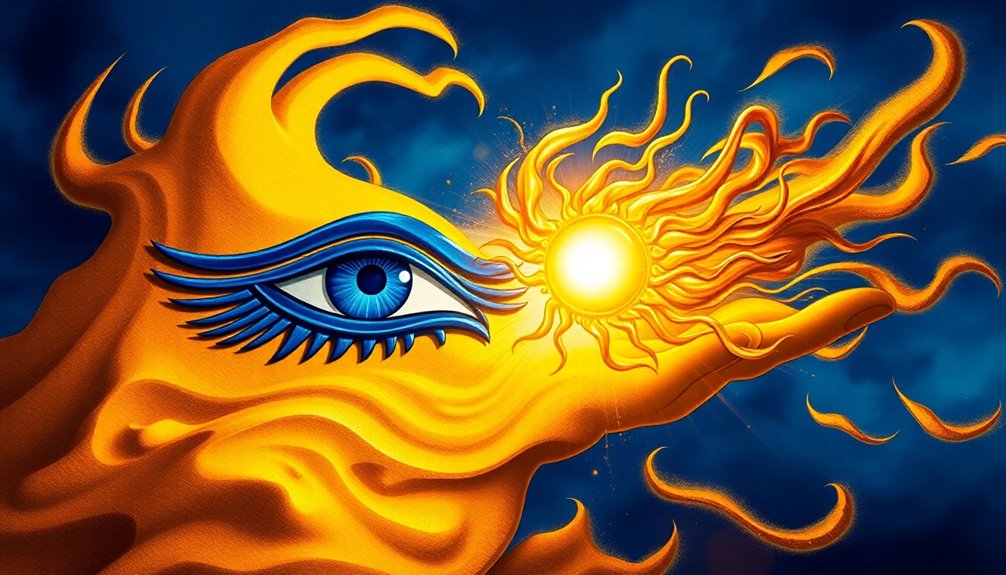
In ancient Egyptian mythology, the symbolism of the Eyes carries deep significance, reflecting the dual nature of divine power. The Eye of Horus, or Udjat, embodies protection, healing, and restoration. Linked to the god Horus, it symbolizes his victory over chaos and his quest to reclaim his rightful throne. You can recognize the Eye of Horus by its distinct falcon-like features, divided into six parts, representing the senses and totaling 63/64—its missing fraction hints at imperfection or magic.
On the other hand, the Eye of Ra represents the fierce and destructive might of the sun god Ra. This eye symbolizes divine authority, often associated with punishment and vengeance against those who defy the gods and goddesses. Typically depicted with a cobra or teardrop, the Eye of Ra emphasizes aggression and chaos.
Both symbols played significant roles in ancient Egyptian culture, often appearing in amulets for protection. However, while the Eye of Horus promotes health and well-being, the Eye of Ra serves as a reminder of raw power and the potential for retribution.
Understanding these symbols deepens your appreciation of ancient Egyptian beliefs and the complexity of their divine narratives.
Myths Behind the Symbols

Ancient Egyptian myths vividly illustrate the origins and meanings behind the Eye of Horus and the Eye of Ra. The Eye of Horus, associated with the sky god Horus, symbolizes healing and protection. This symbolism stems from the myth where Horus's eye was damaged during the battle between Horus and Set. Afterward, Thoth restored the eye, representing resilience and wholeness.
This connection emphasizes balance and restoration, aligning with the duality of life and death.
In contrast, the Eye of Ra embodies the sun god Ra's fierce nature and divine wrath. Myths depict Ra sending his eye, personified as a goddess, to punish humanity for their disrespect. This act showcases the destructive power and vengeance inherent in the Eye of Ra.
While both symbols serve as protective amulets, the Eye of Horus is often linked to healing, whereas the Eye of Ra signifies strength and punishment against enemies.
Each symbol reveals the contrasting natures of Horus and Ra, reflecting themes of protection and aggression in ancient Egyptian mythology. These myths provide insight into how these potent symbols were perceived and utilized in daily life.
Key Differences Explored
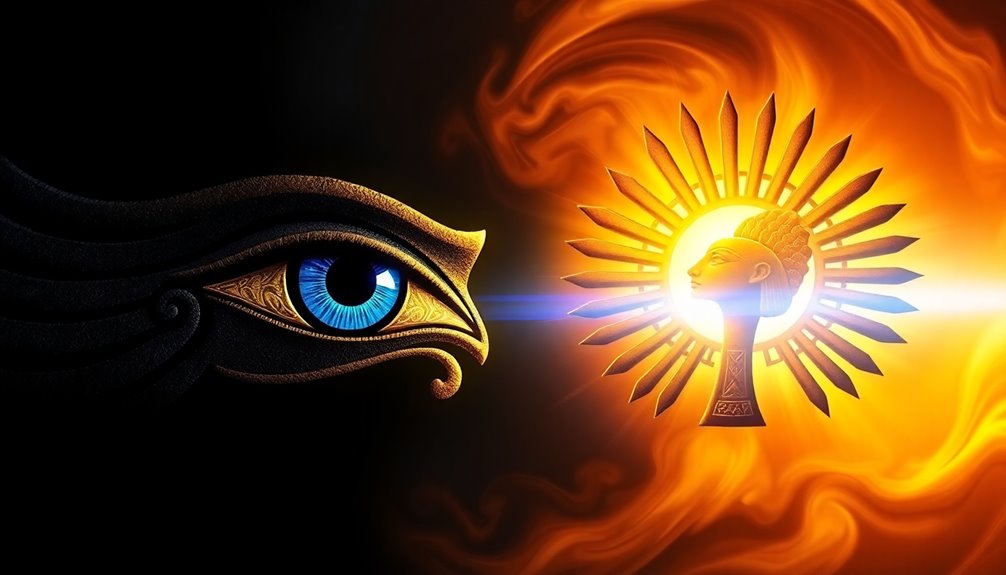
When you compare the Eye of Horus and the Eye of Ra, you'll notice distinct differences in their representation and symbolism.
The myths surrounding these symbols reveal their unique cultural significance and usage in ancient Egyptian society.
Understanding these key differences can shed light on their roles in mythology and daily life.
Representation and Symbolism
While both the Eye of Horus and the Eye of Ra hold significant meaning in Egyptian mythology, they represent contrasting themes that reflect the complexities of divine power.
The Eye of Horus symbolizes healing, protection, and restoration, embodying compassion and balance. This left eye, associated with Horus's battle against Set, is divided into six parts, correlating to the senses and representing completeness. In ancient Egyptian culture, it's a symbol of health and prosperity.
On the other hand, the Eye of Ra, depicted as the right eye, embodies power, destruction, and chaos. Often accompanied by a cobra, it symbolizes Ra's divine wrath and punishment of humanity. This eye represents a more chaotic aspect of divine power, emphasizing authority and fear. While it can serve as a protective force, it also has the potential for severe vengeance when provoked.
Ultimately, these two symbols showcase the duality in ancient Egyptian beliefs, with the Eye of Horus promoting restoration and protection, while the Eye of Ra illustrates the darker, more destructive side of divine authority.
Understanding these distinctions helps you appreciate the rich symbolism behind both eyes.
Myths and Legends
Understanding the myths surrounding the Eye of Horus and the Eye of Ra reveals their key differences and the narratives that shape their meanings.
The Eye of Ra, associated with the sun god Ra, symbolizes power and destruction. In one myth, Ra sends his daughter to punish humanity for disrespect, releasing chaos that he later controls by intoxicating her. This showcases Ra's vengeful aspect, emphasizing his commanding presence in ancient Egyptian beliefs.
In contrast, the Eye of Horus represents healing and protection, linked to the sky god Horus. The myth involving Horus tells of his battle with Set, where he loses his left eye. Fortunately, Thoth restores it, signifying the restoration of balance and order. Here, you see the compassionate nature of Horus and the symbolism of protection that his eye embodies.
Visually, the Eye of Ra often appears as a right eye accompanied by a cobra, while the Eye of Horus is depicted as a left eye with falcon-like features.
These differences in their myths highlight the duality in ancient Egyptian thought—chaos versus order, destruction versus healing.
Cultural Significance and Usage
The cultural significance and usage of the Eye of Horus and the Eye of Ra reveal their profound impact on ancient Egyptian society. These symbols embody key themes in Egyptian mythology, representing different aspects of life and power.
- Eye of Horus: Symbolizes healing, protection, and the balance of chaos and order.
- Eye of Ra: Represents the sun's destructive power, divine authority, and punishment.
- Senses Representation: The Eye of Horus is divided into six parts, correlating with the senses, symbolizing completeness and restoration.
- Cultural Attributes: The Eye of Horus embodies compassion and nurturing, contrasting sharply with the commanding presence of the Eye of Ra, which evokes fear.
You'll see the Eye of Horus frequently used in amulets meant for prosperity and safety, while the Eye of Ra serves as a reminder of retribution against enemies.
Understanding these differences not only enhances your appreciation of ancient Egyptian culture but also highlights how these symbols continue to resonate today as representations of healing, protection, chaos and order, and divine authority.
Cultural Significance and Deities
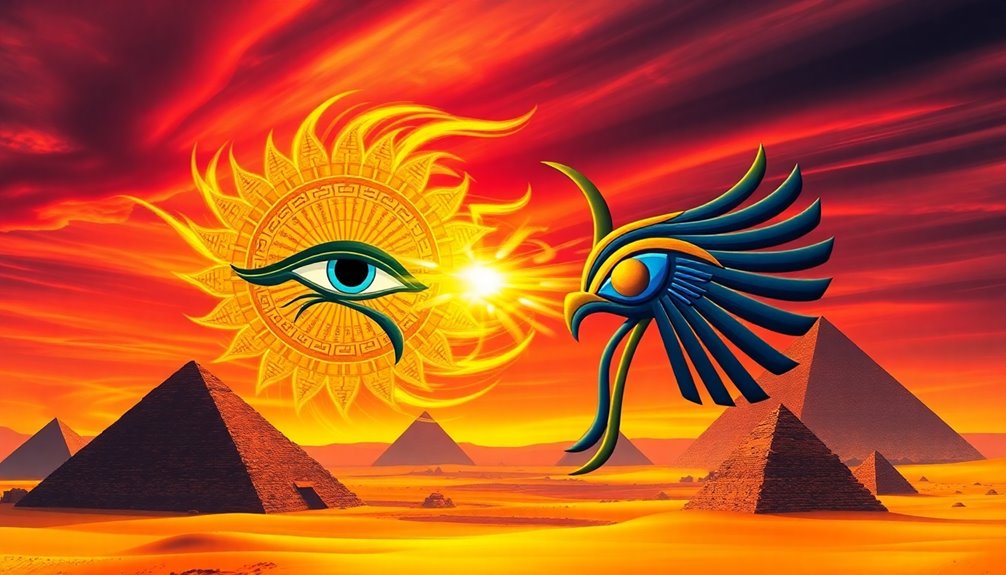
In ancient Egyptian culture, the Eye of Horus and the Eye of Ra served as powerful symbols of protection and authority.
You'll find that the Eye of Horus is closely tied to deities like Hathor and Sekhmet, emphasizing healing and fierce guardianship.
In contrast, the Eye of Ra links to Tefnut and Nekhbet, showcasing themes of divine power and royal protection.
Symbolism of Protection
Throughout ancient Egyptian culture, the symbolism of protection plays an essential role, deeply intertwined with powerful deities and their attributes. The Eye of Horus, or Wadjet, stands as a beacon of healing and restoration, offering protection against chaos and promoting health.
In contrast, the Eye of Ra symbolizes a more aggressive form of protection, embodying power and vengeance, which often aligns with the fierce nature of the goddess Sekhmet.
Both eyes served as significant amulets for the ancient Egyptians, each offering unique forms of protection:
- Eye of Horus: Represents balance between chaos and order, promoting health and prosperity.
- Eye of Ra: Embodies the destructive force of the sun and divine wrath, providing strength and vengeance.
- Associated Deities: Horus symbolizes kingship and compassion, while Ra reflects authority and punishment.
- Cultural Significance: These symbols illustrate the complex interplay of protection in Egyptian beliefs.
The duality of the Eye of Horus and the Eye of Ra highlights how protection in ancient Egypt wasn't just about safeguarding, but also about maintaining balance in a world filled with divine threats.
Associated Deities and Roles
Numerous deities play essential roles in the symbolism surrounding the Eye of Horus and the Eye of Ra, each embodying distinct qualities that reflect their divine functions.
The Eye of Horus, often linked to Hathor, the goddess of love and healing, emphasizes protection and restoration, showcasing nurturing aspects crucial to ancient Egyptian mythology.
In contrast, the Eye of Ra, frequently associated with Sekhmet and Tefnut, represents a fierce destructive force, highlighting themes of punishment and vengeance.
These deities emphasize the duality inherent in ancient Egyptian beliefs. While the Eye of Horus conveys good health and the safeguarding of life, the Eye of Ra connects to the sun's life-giving power alongside its potential for wrathful retribution against disobedience.
Sekhmet, as a lioness goddess, embodies the balance between nurturing and destruction, reflecting the complexity of divine roles.
Practical Applications in Ancient Egypt
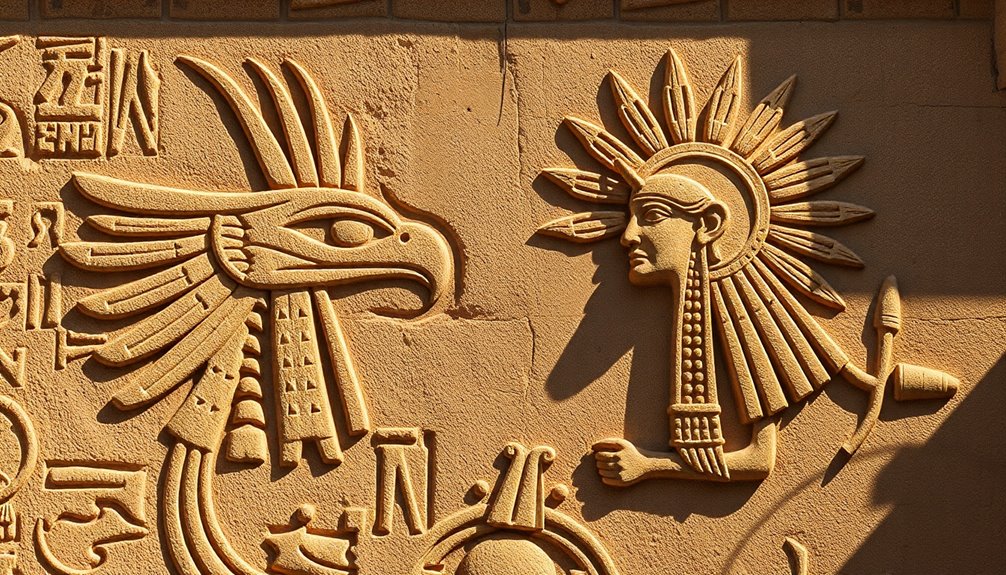
Utilizing symbols like the Eye of Horus and the Eye of Ra, ancient Egyptians integrated these powerful motifs into their daily lives and spiritual practices.
The Eye of Horus, often crafted from gold or lapis lazuli, served as a protective amulet, believed to bring safety, health, and prosperity to its wearer. Each of its six parts symbolized specific fractions, making it essential for measurements and calculations in commerce.
The Eye of Ra, on the other hand, represented the sun's destructive force, invoked in rituals to denote power and protection. You'd find depictions of both eyes in various artifacts, often alongside goddesses like Sekhmet and Tefnut.
Key practical applications included:
- Protective amulets for health and prosperity
- Measurement notation in ancient Egyptian mathematics
- Symbolic representations in burial practices
- Ritualistic use in invoking divine presence
These symbols not only enhanced spiritual beliefs but also facilitated daily activities, showcasing how deeply embedded the Eye of Horus and the Eye of Ra were in the fabric of ancient Egyptian society.
Travel Insights and Recommendations
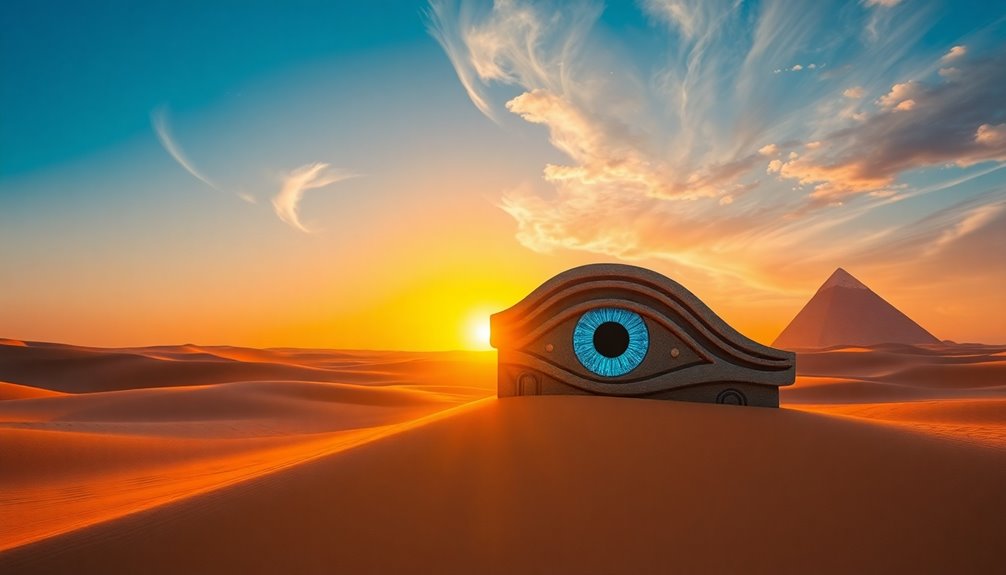
Planning a trip to Egypt can be an exhilarating adventure filled with ancient wonders and vibrant culture. To make the most of your journey, consider visiting between October and April, avoiding the peak tourist season in December and January. This timing allows you to explore sites like the Pyramids of Giza and the Valley of the Kings with fewer crowds.
An estimated cost for an 8-day trip, including a Nile cruise and private guides, is around $1,500 per person, providing an in-depth experience of ancient Egypt's cultural heritage.
Don't forget that most travelers need a visa to enter Egypt; American and British passport holders can easily obtain a visa on arrival for $25 USD.
Safety concerns are minimal in major tourist areas like Cairo and Alexandria, ensuring a generally secure experience.
While exploring, be sure to soak in the mystical vibes of the Eye of Horus and the Eye of Ra, which are deeply rooted in Egypt's history.
With these travel recommendations in mind, you're well on your way to an unforgettable adventure in this incredible land!
Frequently Asked Questions
What Is the Meaning of the Eye of Ra Vs the Eye of Horus?
The Eye of Ra and the Eye of Horus represent two powerful forces in ancient Egyptian mythology.
The Eye of Ra symbolizes power and destruction, embodying the fierce wrath of the sun god.
In contrast, the Eye of Horus stands for healing and protection, reflecting the resilience of Horus after battle.
Both eyes highlight the duality in ancient beliefs, with Ra representing fierce authority and Horus symbolizing nurturing strength and restoration.
Is the Eye of Horus a Good Slot?
If you're seeking an engaging slot experience, the Eye of Horus is definitely worth your time.
It offers vibrant graphics, exciting gameplay, and unique bonus features like free spins and expanding wilds.
You'll find that its wild symbol enhances your winning chances, making each spin thrilling.
Plus, the rich mythology behind the Eye of Horus adds an educational twist to your gaming.
Immerse yourself and enjoy the adventure this slot has to offer!
What Is the Third Eye in Egypt?
The Third Eye in ancient Egyptian culture represents enlightenment and spiritual awakening.
When you think of it, you're tapping into the idea of seeing beyond the physical domain. It's closely linked to the Eye of Horus, symbolizing wisdom and insight.
This connection emphasizes divine protection and healing, suggesting that spiritual vision keeps you safe from harm.
The Third Eye also relates to the pineal gland, often regarded as the seat of the soul.
Is It Okay to Wear the Eye of Horus?
Yes, it's generally okay to wear the Eye of Horus, but you should respect its cultural significance.
This ancient symbol offers protection and healing, making it popular in jewelry and tattoos today.
While embracing its positive meanings, remember its origins in ancient Egyptian beliefs.
Conclusion
In the epic clash between the Eye of Horus and the Eye of Ra, you've uncovered a rich tapestry of symbolism and significance that shaped ancient Egyptian culture. Remember, "the eyes are the windows to the soul." Both symbols offer profound insights into protection, power, and divine connection. As you explore these ancient meanings, you'll carry a piece of their legacy with you, deepening your appreciation for the mysteries of the past.

